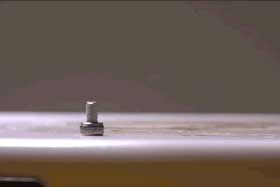3D-printed shape-memory polymers to aid in drug delivery, solar panel tracking

In a new research that is supported in part by the SUTD Digital Manufacturing and Design Centre (DManD) and the SUTD-MIT joint postdoctoral programme, engineers from Massachusetts Institute of Technology (MIT) and Singapore University of Technology and Design (SUTD) are using light to print 3D structures that “remember” their original shapes.
According to Nicholas X. Fang, associate professor of mechanical engineering at MIT, shape-memory polymers that can predictably morph in response to temperature can be useful for a number of applications, from soft actuators that turn solar panels toward the sun, to tiny drug capsules that open upon early signs of infection.
He says that they ultimately want to use body temperature as a trigger. “If we can design these polymers properly, we may be able to form a drug delivery device that will only release medicine at the sign of a fever, ” he said.
Fang’s coauthors include former MIT-SUTD research fellow Qi “Kevin” Ge, now an assistant professor at SUTD; former MIT research associate Howon Lee, now an assistant professor at Rutgers University; and others from SUTD and Georgia Institute of Technology.
Ge said the process of 3-D printing shape-memory materials can also be thought of as 4D printing, as the structures are designed to change over the fourth dimension — time.
“Our method not only enables 4-D printing at the micron-scale, but also suggests recipes to print shape-memory polymers that can be stretched 10 times larger than those printed by commercial 3-D printers,” Ge said. “This will advance 4D printing into a wide variety of practical applications, including biomedical devices, deployable aerospace structures, and shape-changing photovoltaic solar cells.”
Fang and others have been exploring the use of soft, active materials as reliable, pliable tools. These new and emerging materials, which include shape-memory polymers, can stretch and deform dramatically in response to environmental stimuli such as heat, light, and electricity — properties that researchers have been investigating for use in biomedical devices, soft robotics, wearable sensors, and artificial muscles.
Shape-memory polymers can switch between two states: a harder, low-temperature, amorphous state; and a soft, high-temperature, rubbery state. The bent and stretched shapes can be “frozen” at room temperature, and when heated the materials will “remember” and snap back to their original sturdy form.
To fabricate shape-memory structures, some researchers have looked to 3D printing, as the technology allows them to custom-design structures with relatively fine detail. However, using conventional 3D printers, researchers have only been able to design structures with details no smaller than a few millimetres. This size restriction also limits how fast the material can recover its original shape, Fang said.
To print shape-memory structures with even finer details, the team have pioneered using a printing process called microstereolithography, in which, they use light from a projector to print patterns on successive layers of resin.
The researchers first created a model of a structure using computer-aided design (CAD) software, then divide the model into hundreds of slices, each of which they send through the projector as a bitmap — an image file format that represents each layer as an arrangement of very fine pixels. The projector then shines light in the pattern of the bitmap, onto a liquid resin, or polymer solution, etching the pattern into the resin, which then solidifies.The researchers then looked through the scientific literature to identify an ideal mix of polymers to create a shape-memory material on which to print their light patterns. They picked two polymers, one composed of long-chain polymers, or spaghetti-like strands, and the other resembling more of a stiff scaffold. When mixed together and cured, the material can be stretched and twisted dramatically without breaking.
The material can also bounce back to its original printed form, within a specific temperature range — in this case, between 40 and 180 ºC or 104 to 356 ºF).
To demonstrate a simple application for the shape-memory structures, the researchers printed a small, rubbery, claw-like gripper. They attached a thin handle to the base of the gripper, and then stretched the gripper’s claws open. When they cranked the temperature of the surrounding air to at least 40ºC, the gripper closed around whatever the engineers placed beneath it.
Going forward, Fang hopes to find combinations of polymers to make shape-memory materials that react to slightly lower temperatures, approaching the range of human body temperatures, to design soft, active, controllable drug delivery capsules. He says the material may also be printed as soft, responsive hinges to help solar panels track the sun.
Fang explained that very often, excessive heat will build up on the back side of the solar cell, so shape-memory materialscould be used as an actuation mechanism to tune the inclination angle of the solar cell. Other applications for the memory-shape polymers may soon be underway.
(PRA)Copyright (c) 2016 www.plasticsandrubberasia.com. All rights reserved.












































